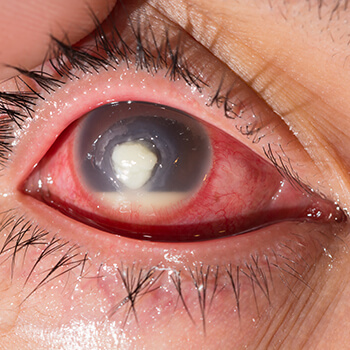Corneal Ulcer
 The cornea is the clear front window of the eye. An infection of the cornea is called a corneal ulcer. This is a serious infection. It may have a good outcome with good vision, but it may also lead to significant vision loss.
The cornea is the clear front window of the eye. An infection of the cornea is called a corneal ulcer. This is a serious infection. It may have a good outcome with good vision, but it may also lead to significant vision loss.
The most common cause of a corneal ulcer is the use of contact lenses. Other causes include injuries, foreign bodies, and trauma.
Depending on the size, location, and duration of the eye infection, it may be necessary to perform diagnostic testing before any treatment is begun. Testing usually involves taking a sample of the area (“culture”) to look for the bacteria (or another organism) that is causing the infection. If the ulcer is small and not centrally-located, it is sometimes possible to treat the infection without first doing this testing.
The treatment of a corneal ulcer typically involves using antibiotic eye drops at very frequent intervals. Many patients will initially be required to wake up several times throughout the night to use their eye drops. In certain cases, another type of eye drop that dilates the pupil will also be needed. In addition, patients must come in for frequent evaluations. This may be every day or every other day in the early stages of the infection.
The time required for the infection to resolve varies with the severity of the infection. In most cases, it is a marathon and not a sprint.
Over time, as the infection improves, symptoms of pain, redness, and light sensitivity will decrease; the frequency of the eye drops will decrease, and follow-up visits will be spaced further apart.
After the corneal ulcer is healed, it can result in a scar. If a scar forms, patients may only be able to achieve their best vision by using a hard contact lens. Rarely, if vision is significantly compromised by the scar, surgical treatment (corneal transplant) may be required.
Visit the American Academy of Ophthalmology’s EyeSmart® website to learn more about Corneal Ulcers.



